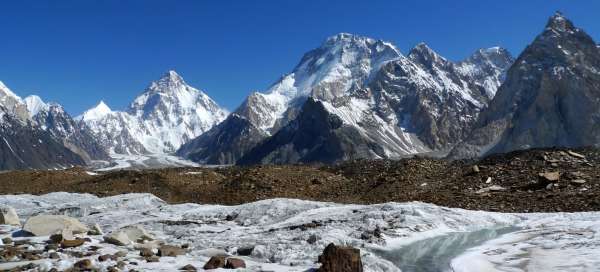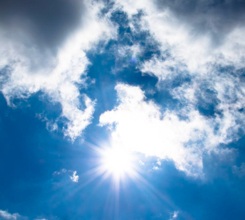Altitude sickness / mountain sickness
Unpleasant guide in the high mountains

One of the biggest dangers at high altitudes is called altitude or mountain sickness, which can not only cause serious health problems, but also death. It arises due to poor oxygen supply to the body caused by the drop in air pressure with increasing altitude. It is therefore necessary to devote time to the so-called acclimatization during each trek or mountain climbing at high altitude. Proper acclimatization can eliminate some unpleasant effects of altitude sickness. Time devoted to acclimatization will reward you with higher probability that you will enjoy peak panoramas without headaches.
Zones of altitude sickness
The effect of altitude on the body
- Completely safe zone 0–2 500m asl: For most people absolutely safe zone without almost any effects of altitude.
- Safe zone 2 500–3 300m asl: Most people already notice that when they breathe worse. But only few people, however, suffer here any unpleasant symptoms of altitude.
- Slightly dangerous zone 3 300–4 000m asl: If you shall sleep at such heights, you should already think about acclimatization. If you ascent to such heights during one day and then you sleep „low“ you do not need to think about it.
- Dangerous zone 4 000–6 000m asl: zone in which not acclimatized individuals may suffer from significant symptoms of mountain sickness. Nevertheless, it is still the zone for which you can acclimatize and stay here even for long time. Highest inhabited villages in the world have about 5 500m asl. But people living here, however, have far more red blood cells than people living in „normal“ heights.
- Very dangerous zone 6 000–8 000m asl: it is not possible to stay here for a long-term due to the gradual degradation of the body. During mountain ascents you must follow the elaborate acclimatization plan.
- Zone of the death of more than 8 000m asl.: Most people survive here only with breathing apparatus. It is extremely dangerous to sleep at such heights.
In brief: You do not need to think about altitude sickness up to four thousand meters above sea level. Then yes, especially for sleeping. The limit of really high altitude is at about six thousand meters above sea level.
Factors improving / worsening condition
What you can do to improve the adaptation to heights
- Genetics: Unfortunately it is true, your resistance to high altitude is strongly determined by genetics. Two trekkers / climbers with similar condition observing the same acclimation plan may turn out very differently. One will suffer with headaches and the other will have no symptoms. It is thus ideal to test yourself gradually (3500–4000–4500 etc.) within the individual expeditions and just not want to climb eight-thousand meters high mountain immediately (even if your condition is perfect). If you notice that your body tolerates the altitude worse than others, you have to think more about acclimatization. Conversely, if you find that you have no problem with high altitude, you can shorten the sometimes very long acclimatization program.
- Age: age also has an effect on high altitude tolerance. It is worst tolerated by small children and young people.
- Physical constitution: muscles consume large amounts of oxygen and it is the reason why is altitude better tolerated by wiry rather than brawny people. So if you plan an expedition to heights, it is certainly better to run or ride a bike rather than go to the gym.
- Dehydration: Quality drinking regime is important at all altitudes, but twice important at heights. Dense blood worse supplies oxygen to the body (in addition, it can cause frostbites or blood clots). Furthermore, many people do not feel the need to drink so often at heights, which deepens the problem.
- Coldness: quite often underestimated influence. Cold speeds up our metabolism, so you have greater oxygen consumption. If it is possible and natural conditions allow, try to ensure being in warm.
- Alcohol: Drinking alcohol at high altitudes is generally not recommended. The absorption of alcohol into the blood at the same time reduces the amount of oxygen absorbed. At the same time alcohol dehydrates the body. Moreover, the effect of alcohol is up to 3 times stronger at high altitudes than at sea level, so it considerably increases its negative effects such as the (un)certainty of walk, which is absolutely crucial in the mountainous terrain.
- Food: fatty food is not appropriate at high altitudes. The body does not have enough oxygen to convert such food to energy. Far better are light meals with lots of sugar and minerals.
- Weather: strangely enough, the weather has an impact on altitude toleration. High atmospheric pressure – good weather – improves oxygenation. Conversely, low pressure – bad weather – it worsens.
- The speed of your walk: It is recommended to walk purposefully slow at high altitudes. Experienced mountain guides often ascent “at snail's pace”. Rapid movement tires and mainly consumes a lot of oxygen.
- Walking: it is always better to walk to greater heights gradually on your own rather than get there during a few hours by car.
- Good physical fitness: Endurance training generally reduces the time needed for acclimatization.
- Good health: Definitely not the most important factor for altitude tolerance. But poor health, particularly in the respiratory area may in combination with the high altitude cause complications much earlier and they can be much worse.
In brief: be born with good genetics, run a lot to be wiry and fit. Ascend slowly, ideally in good weather, wear warm clothes and drink lots of water and no alcohol. And not set out if you are ill.
Acclimation program
How to deal with high altitude
- Acclimatization – mantra of all climbers and trekkers moving in the high mountains. It is about gradual increases in altitude and thus getting the body used to significantly lower supply with oxygen. If you acclimatize well, you can eliminate altitude sickness and its annoying and dangerous symptoms. The nice thing about acclimatization is that it remains (individually) up to one year.
- Ideal altitude if the first overnight stay: the success of the entire trek or mountain ascent at high altitudes is usually dependent on planning the height of each overnight stay, because the symptoms of mountain sickness usually become apparent at night. The first night on any expedition shall not be for not acclimatized person higher than 3 300–3 500 asl. /if higher, acclimatization is recommended/.
- Height of the subsequent nights: Subsequent increase in height during other nights should be gradual, ranging from 300 to 500 altitude meters a day. This is easy to say, but sometimes difficult to apply.
- Go high – sleep low: this is another classic rule for good acclimatization. During the day, you can be at about 300 altitude meters higher than the place where you are going to sleep.
- Rest days: Relaxation day is recommended after roughly each 1,000 altitude meters (4 500 – 5 500 m etc.). Idealists and theorists recommend around 2–3 days, but only a few people can afford it. However, if you have the time and what to see in the surroundings, it is definitely the best option.
- Temporary planned descents: It is not so important for us travelers and trekkers for which is usually a reasonable height up to 6,000 meters above sea level. But high mountain climbers overcoming really high altitudes must, from time to time, return for example kilometer down, relax and just then continue in the ascent.
In brief: duration of acclimatization will depend, of course, most on the highest point you must overcome, or more precisely on the highest point of the night. 3 days are enough at 4 000m asl, a week at 5 000m asl.
Forms and symptoms of mountain sickness
What can happen if you underestimate
- Acute Mountain Sickness – AMS: The most common and mildest form of altitude sickness, which was experienced by almost everyone who ran to a height very quickly. The most common symptoms are headache, insomnia, exhaustion, loss of appetite, nausea and drowsiness.
- High Altitude Pulmonary Oadema – HAPE: it is already a very serious. It can be recognized by the cough with occasional foaming phlegm or blood. Great exhaustion, sometimes almost impossible to stand up.
- High Altitude Cerebral Oadema – HACE: The most serious condition often ending in death if not solved quickly! Affected individual often acts insane, suffer from hallucinations, can be aggressive or completely apathetic, not able to stand up. Loss of coordination and balance – hold not on his/her feet. It may appear like a drunk.
In brief: do not really underestimate altitude sickness. In the best case you spoil the ascent or trek, in worse case your health.
How to fight with already broken altitude sickness
Not to be ashamed to go down!
- Soft symptoms: if you begin to suffer from mild symptoms such as frequent headaches, see. AMS, try to wait at the same height for the next day – symptoms should subside.
- Deteriorating mountain sickness: if you still ignore soft symptoms and still rise above, your condition will most likely get worse, sometimes very quickly. Here helps only the descent below – often only 500–1000 altitude meters suffice.
- Serious health condition: if you underestimate the worsening symptoms, very dangerous (also deadly) brain swelling can burst out. The only solution is the descent down – the lower, the better. Additionally, usually with the assistance of others, because you will not have the mental and physical abilities to do so. The improvement mostly comes below four thousand meters above sea level.
In brief: if you feel any signs of altitude sickness, do not ascend higher. If they deteriorate, go down quickly.
Medication
What can help
- Standard pills for a headache are often not helpful because you will not realize so quickly that the symptoms of mountain sickness worsen.
- Diamox: often used as prevention but also as a cure. But it has side effects.
- Dexamethasone: for the brain oadema
- Nefidipin: for pulmonary oadema



